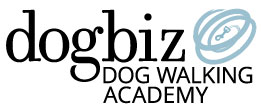dogbiz Dog Walking Academy
5 Dog Training Tips for Dog Walkers
While it may not be a dog walker’s “job” to train dogs, a basic training toolbox is part of the professional dog walker’s skill set, helping to keep dogs safe and make the job easier and more enjoyable.
Training means walking dogs instead of being walked by them. It means getting and keeping a dog’s focus, making it easy to move past distractions like squirrels, children, garbage on the ground, and other dogs. For off-leash walkers, training keeps off-leash dogs nearby, and ensures they come when you call.
Walking dogs is fun, but walking calm, responsive dogs is a blast (and much safer, too). It’s also good marketing; nothing looks quite as impressive as a dog walker in full charge of her cheerful four-legged clients.
Here are 5 key training tips to make your pro dog walks easier, safer, and more enjoyable:
1. Reinforce behavior you like—you’ll get more of it
The laws of operant conditioning tell us that rewarded behavior increases and ignored behavior decreases. Simply put: dogs do what works. Never miss an opportunity to reward dogs for behavior you’d like to see more of. Is a dog sitting nicely? Find a way to tell him thanks. When an off-leash dog checks in with you, let him know you appreciate it with a treat or the throw of a ball. Like it when a dog comes when you call or walks nicely on leash by your side?
We’re very quick to tell children, dogs, and those below us at work, “No.” We’re always quick to punish. But we’d get more done by saying “Yes” more often by rewarding good behavior.
2. Use life rewards
Giving a treat is a tremendously effective way to tell a dog what you like. But it’s not the only way. As a dog walker, you hold control over a long list of items on most dogs’ favorite things list: Having a leash clipped on for a walk, having the door opened to the wonderful outdoors, having a leash taken off for some free play, having a ball thrown, being allowed to move forward on leash toward a good smell or item to investigate, and on and on.
You can use these life rewards to build a wonderfully-mannered dog simply by asking for polite behavior to gain access to them. If a dog wants her leash clipped on, she’ll need to sit for it. Would she like her ball thrown? Another sit. Want to go smell the hydrant? No problem, so long as there’s no pulling to get there. Using life rewards provides a systematic way to train the dogs you walk as you enjoy your time with them.
3. Don’t reinforce behavior you don’t like
It’s a simple concept, but so easy to forget in practice. A dog barks and we forget ourselves and throw the ball. A dog jumps on us when we enter their home and we reward the jumping by leashing them up for the walk. We allow dogs to pull us down the sidewalk.
Remember: dogs do what works. Unless you enjoy being barked at, jumped on, or dragged along, be careful not to reinforce these behaviors, or any others you don’t want to see more of.
4. Remove rewards for behavior you don’t like
Ignoring behavior you don’t like can be enough to eliminate it, but it can take time. And some behaviors, like barking, can be intrinsically rewarding, and thus resist this strategy.
To have a quicker impact on behavior, remove whatever reward the dog is after. Instead of throwing the ball for a dog who is barking at you to do so, walk away. (Or, even better, pick up the ball and put it in your pocket for a minute or two.) When a dog jumps on you as you enter his house, turn around and leave. Stand on the front porch for a moment before trying again. Repeat this as many times as needed. When the dog finally does not jump on you, reward him by clipping on his leash. When a dog pulls on leash toward a great smell, turn around and walk him in the other direction for a few paces before giving him another chance to walk calmly toward his goal.
You may need to plan extra time for the first few days of this kind of training, but it’ll pay off in years of easy walking.
5. Be consistent
Behavioral science has revealed a challenging phenomenon: Intermittent reinforcement strengthens behavior. That’s why dogs who are only occasionally fed at the table become such dedicated beggars. (It’s also why gambling is so addicting.)
So be careful; once you decide to no longer reinforce behaviors like pulling, barking, or jumping, stick to your guns. You can work consistently for weeks teaching a dog not to pull on leash, but it only takes bending the rules one day when you’re feeling rushed to undo all of that work.
Dog walkers arguably have the best job on Earth, but it isn’t an easy one. A robust basic training toolbox elevates dog walking to a professional level, making what is already arguably the best job on earth easier, safer, and more enjoyable—for dogs and dog walker alike.

Enjoy a free subscription to Two Feet Forward, the definitive e-newsletter for the modern dog walker
- Dog walking business tips
- Dog behavior tips
- Career development opportunities
- Industry discounts

Ready to take your dog walking business or career to the next level?
Become a certified professional dog walker through the premier dog walking school.
Learn about the Dog Walking Academy >>


